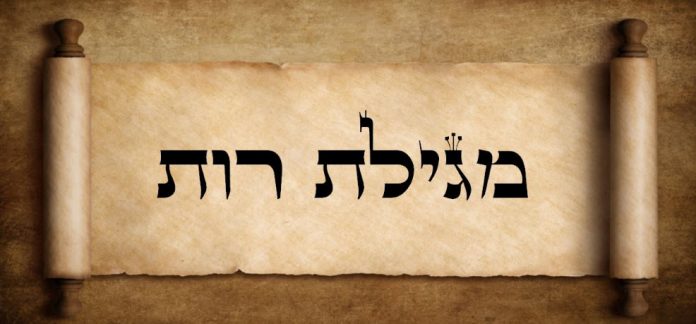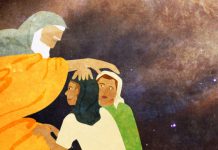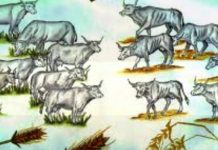The Book of Ruth is read in synagogue on Shavuot morning. A chapter-by- chapter explanation.
“I don’t understand how a man of his standing could just leave like that? Pick himself up, with his wife and two sons, liquidate his assets, and just run away! And just at a time when we’re in the middle of a terrible famine!” proclaimed Reuven.
His friend Shimon tried to give Elimelech the benefit of the doubt. “We all are aware that Elimelech is a Torah scholar as well as a very generous philanthropist. At the yearly dinners of all worthy causes he always pledged substantial donations. It was only the fact that all those hungry people wouldn’t give him a moment’s peace of mind that caused him to abandon ship. From morning until evening, at home and in the study hall, they begged for his assistance until he couldn’t take it any longer. Can you really blame him?”
“But families are starving,” replied Reuven, “What other recourse do they have than to beseech their better off brothers?”
Shimon answered, “The halacha states that a mitzvah that can be performed by others does not absolve one from the obligation of Torah study. Elimelech wanted to study Torah undisturbed, so he ran to the fields of Moab, far from the bad influences of the big cities, and left the mitzvah of charity to others. May the Almighty forgive him!”
The Book of Ruth is read on the holiday of Shavuot, the traditional anniversary of the death (and birth) of King David. The book relates the story of a remarkable gentile woman who joins the Jewish people and became David’s ancestor.
Another connection between the story of Ruth and Shavuot is the concept of “accepting the Torah” in all its details, which Ruth so eloquently proclaimed, and which is required by all converts. On Shavuot we relive the event at Sinai at which the entire Jewish people accepted the Torah.
In addition, the setting of the book is at the time of the wheat harvest, precisely when the holiday of Shavuot takes place.
Chapter One – Days of Judges
“And it was in the days of the judging of the judges” (Ruth 1:1). The simply meaning of this is, “When the judges judged.” However, the Sages interpret this homiletically as, “The people judged their judges!”
The 300-plus years of the Jewish Judges in Israel (before the reign of the Kings) was unique in the history of mankind. A judge was appointed by popular consent (not elected) and he decided private and public affairs, as well as setting national policy.
However, he had no means to enforce his decisions. He had no police force or army (which was purely voluntary when required for war) to carry out his orders. The entire nation ran on the “honor system” for over 300 years!
Although in the Book of Judges we find two national calamities that are attributed to the fact that “there was no king in Israel,” implying that a monarch with power might have prevented those events, all in all, two events in 300-plus years is a pretty good track record. What would happen in New York City in one day without a police force? (or even with a police force!) (Rabbi Avigdor Miller)
The story of Ruth takes place during the period between judges when there was no authority. Poor people threatened to “empty out” the rich, and there was no one to prevent it. This might have also caused Elimelech to panic and leave Israel.
The Famine
“There was a famine in the land, and a man left Bethlehem in Yehudah (the center of Jewish life before Jerusalem) to sojourn (temporarily) in the fields of Moab (peace and quiet), he and his wife and their two sons.” (Ruth 1:1) He was the catalyst, and his wife and sons reluctantly accepted his decision.
“His name was Elimelech” from the aristocratic family of Judah. “His wife’s name was Naomi (‘pleasant,’ well known for her many charitable projects) and his sons were (appropriately) named Machlon (‘sickness’) and Chilyon” (‘finished,’ which is what eventually befell them). (1:2)
“They came to the fields of Moab and they were there.” (1:3) To leave Israel for the Diaspora is very easy, just get on the plane and you are there. To return later is much more difficult!
The Death of Elimelech
Although Elimelech may have had many rationalizations to excuse leaving Israel, in the eyes of God he was guilty of deserting his people in their time of need. Since this was a great “desecration of God’s name,” he was punished by early death.
Intermarriage
Naomi, the widow, should have immediately returned to Israel. But she remained on a “tourist visa” for another 10 years! Without their father’s supervision, and for lack of any Jewish women, the sons married local women — Orpah and Ruth, the daughters of Eglon the Moabite king. This was also regarded as an affront to the Jewish people, and the brothers were both dealt the consequences by God.
Question: Did Orpah and Ruth properly convert to Judaism or not? If not, then they were never legally married, so why is Ruth referred to as the wife of Machlon and heir to his fields in the end of the book? If they were proper converts, then why does Naomi attempt to persuade them to return to their idolatrous worship?
Answer: The commentaries explain that of course they underwent a conversion process, but the conversion’s validity depended on whether they were really sincere. If they returned home (as Orpah did), it revealed that she never fully accepted Judaism in the first place. If they remained (as Ruth did), that shows she was always Jewish and was a proper widow of her husband.
First Goes the Money
The Almighty sends warning signals first. Elimelech and his sons lost all of their wealth, in order to awaken them to repent, but alas, to no avail! “Elimelech the husband of Naomi died” (1:3). She was no longer the wife of the millionaire baron, rather he was known as “the husband of the famous Naomi,” known for her noble deeds (Malbim).
When the two sons died, there was no money for burial shrouds, and the princesses Orpah and Ruth had to pay for their husbands’ burial expenses! This downturn was the result of straying from the mainstream of the Jewish people (Midrash).
Naomi Tries to Dissuade Them
Scene: A quiet road in the fields of Moab. Three women are crying. Jewish history is being made…
Naomi is on her way back to the Land of Israel, accompanied by her daughters-in-law. Naomi expects them to go back to Moab, and is surprised that they remain with her. She attempts to persuade them to return: “And Naomi said to her daughters-in-law, ‘Return my daughters to your mother’s home. May the Almighty repay you for the kindness you have shown your dead husbands and myself, and may you find rest in a new married life’.” (1:8)
Naomi is telling the women to return to their mothers, but advises them that if they really want “rest,” they should return to Moab and remarry.
Question: Isn’t a mother’s home more restful than a house full of kids and all that it entails?
Answer: Naomi didn’t mean physical rest, which is obviously more available in a mother’s house. Rather she refers to “inner peace” which a woman experiences more fully when she has a family.
“They replied: ‘We will return with you to your people’.” (1:10) Naomi’s first attempt is rejected, and Ruth and Orpah sincerely want to stay with the Jewish people. Since they have no ulterior motives, any Jewish court would have accepted them as sincere converts with no additional attempts to dissuade them. However, “Rebbetzin” Naomi does not give up. “Return my daughters, go! For I am too old to remarry. Is there any hope for me? Even should I remarry tonight and also give birth to sons, would you wait for them to grow up to marry you? If so you will never get married. Do not do so, my daughters, because I am embittered an account of you, as the hand of the Almighty has punished me.” (1:13)
Naomi is advising them: Your goal is to find rest with a husband and to remarry. With me there is no hope. Even if I remarry tonight and give birth to sons! The odds of an old widow remarrying are 1-in-1,000. To remarry tonight is 1-in-10,000, and to give birth — the computer explodes! And even so, you could not wait for them to grow up. Therefore my advice is to return to your non-Jewish family. (Heard from Rabbi Shlomo Brevda)
Orpah Leaves, Ruth Remains
Orpah responded: “Yes, you are my mentor and rebbetzin, and have taught me logic. Since my goal is to get married and with you there is no chance (especially being a convert), I must leave.” She kissed her mother-in-law and took her leave.
Ruth, however, clung to Naomi. “How can I even consider leaving you? What difference does it make if I get married or not? I want the Torah and all that it encompasses!”
Many years later, a battle was fought between the great grandson of Ruth, David, and that of Orpah, Goliath. The Sages comment that it was fitting that David — the descendent of the one who clung — should be victorious over the one that kissed and left. Our decisions can have impact even generations later!
At this point, Ruth’s sincerity is obvious, and yet Rebbetzin Naomi still makes an effort to dissuade her. “Why don’t you follow your companion to her people?” (1:15), she demands.
Ruth replies: “Do not entreat me to leave you. Where you go, I will go. Where you lodge, I will lodge. Your nation is my nation. And your God is my God. Only death will separate us!” With this declaration of faith, Ruth accepts the Torah in its totality.
The Sages infer from this that a prospective convert must be informed of specific difficult and easy mitzvot (and even infer which ones Naomi presented Ruth with and she accepted). Ruth is informing Naomi of her intention to be a Jew in any case, even if Naomi leaves her, but she would much prefer to remain with Naomi.
At this point even Naomi is ready to accept her, but there still remained one more test: “And she saw her efforts to come with her, so she refrained from speaking with her.” (1:18) Naomi walked as an older woman, slowly praying as she went. Ruth walked as any young woman would, however now she was trying her best to emulate Naomi’s pace and manner, which took much effort on Ruth’s part. Now even Naomi was convinced of her total sincerity. (Rabbi Brevda)
Arrival in Bethlehem
To return to Israel from abroad was very complicated. “She left the place she was, to go on the path to return to the land of Judah” (1:7). “And they went and came to Bethlehem and behold they came to Bethlehem” (1:19). “And Naomi and Ruth returned from the fields of Moab and arrived in Bethlehem at the season of the barley harvest” (1:22)
These verses say that she left to go to return, and went and came and came (again), and returned and arrived! To return to Israel is not simple because it is more than a physical move, but is also a spiritual elevation. (Rabbi Brevda)
“When they entered Bethlehem, the entire city was in commotion — is that Naomi?” (1:19) She replied, “Do not call me Naomi (pleasant) but rather Marah (bitterness) because God has punished me.” This was quite unsettling for Ruth to hear her mentor confess in public!
Question: Why was the entire city watching their entrance? And how did they have the heart to embarrass a widow in public, saying, “Is that Naomi”?
Answer: On the day that Ruth accepted the Torah, the wife of Boaz the Judge died, and the following day was her funeral, attended by the entire population. In the middle of the funeral at the cemetery outside of town, Naomi and Ruth arrived. (Talmud)
Of course, the townspeople did not intentionally shame Naomi; it was their spontaneous reaction. They remembered Naomi as a young, attractive, wealthy woman always helping others, and suddenly a broken old widow who looked strangely familiar confronted them. In shock, they proclaimed, “Could this be the same Naomi?!” (Rabbi Brevda)
Chapter Two – Introduction
1) In an agricultural society the distribution of grain to the poor was accomplished in three ways (see Leviticus 19:9):
- Peah — Allotting a corner of the field to the poor, which the poor could choose to divide equally or for everyone to grab whatever they could get.
- Leket — When the harvesters would cut stalks of grain, if one or two stalks would fall to the ground, they were left for the poor.
- Shik’cha — When gathering the bound sheaves of grain, if one or two sheaves were forgotten, they must be left for the poor. At harvest time, the poor would follow after the harvesters to glean whatever they could get.
2) The inheritance of land that every Jew received in Israel was not to be sold unless in case of great need. The seller’s relatives had an obligation to redeem the field if the seller himself could not afford to. If a widow inherited her husband, it was customary for the redeemer to marry the widow, so that the name of the original owner would be remembered on the land. (“Can you see Mrs. Green on the field, her first husband, Mr. Brown had once owned this field.”)
3) The Torah forbids a Jew from marrying a Moabite — even a convert! The oral tradition explains this was only a prohibition against Moabite men, but it is permitted to marry a Moabite woman who converts. This oral tradition was not well known at the time, due to the fact that the amount of Moabite converts seeking to marry Jews was minimal — i.e. only Ruth!
Enter Boaz
The present Judge of Israel was Boaz, the nephew of Elimelech, a distinguished elder scholar who had recently lost his wife. Naomi refused to ask for his assistance, and waited for him to make the first move. In the meantime, Naomi and Ruth were starving to death because they had arrived at the harvest time, and the fields of Elimelech had not been planted. Naomi had the option to sell her fields, and Boaz her relative would be obligated to redeem the fields. Ruth offered to glean in the fields with the poor, as no one would recognize her and shame her, as they would have the former wealthy Naomi. Naomi gave her permission (otherwise the book would have ended here with two more funerals).
Ruth Gleans the Fields of Boaz
“And she went and she came and happened upon the fields of Boaz, the relative of Elimelech.” (2:3)
Question: Why did Ruth go and come twice?
Answer 1) She wanted to make sure that she knew the way home, so she made signs along the way and backtracked to be certain of the path.
Answer 2) She left a number of times, but waited until she found a group of gleaners that she felt comfortable with.
Answer 3) Instead of gleaning in the direction that would take her further from home, she went to the end of the field and came back toward her home so she would not have far to carry her load of grain (Vilna Gaon). She was a “beginner fundraiser” and already knew the tricks of the trade!
Providentially she arrived at Boaz’s fields and gleaned all morning.
Boaz Arrives on the Scene
As noon approached, the boss arrived and immediately noticed Ruth. “Boaz inquired of his manager, to whom is that maiden?” (2:5) The Sages ask: Why did Boaz inquire about this woman? Did he notice every woman in the field? The answer: He noticed that Ruth was modest and scrupulous about the laws of gleaning.
Question: Did Boaz notice every modest, religious girl on the field?
Answer: In order to avoid quarreling with the poor people over Peah (which was divided among the poor) or with the harvesters over the sheaves which were valuable (Shik’cha), Ruth gleaned only the individual grains (Leket). Since she was the only one there, she was able to accumulate quite a bit of grain, so that Boaz, seeing her as the only woman in the field bulging with grain, figured that she must be related to some harvester who was now throwing her his expensive grain. “To whom is this maiden?” he declared! (Malbim)
Another approach: This was the first harvest after years of drought. The women who gleaned were desperate to feed their hungry children. They grabbed in an immodest manner every grain they could get their hands on. Only one woman was stooping modestly instead of bending over, and was strict about how many grains could be taken. She must have a mentor who taught her these important principles. “To whom is this maiden?” he declared. “Who taught her all of this?” The reply was that she was the daughter-in-law of Naomi, who schooled her in the laws of modesty. (Rabbi Brevda)
Boaz Extends his Invitation
Boaz invited Ruth to eat with him, explaining how he was impressed that she accompanied her mother-in-law. Ruth ate her full and put the rest in a “take-home container” for Naomi. Boaz advised her to stay with his harvesters, and when she is thirsty she may drink from the water barrel. He warned his men not to disturb her, and she continued to glean until the evening.
When she finished, she beat the chafe and ended up with an “eifah” (a large measure) of grain. She brought the grain home to Naomi, along with the leftovers of her meal. Naomi was very impressed, and inquired who was the owner of the field that allowed her to take so much grain. Upon hearing the name Boaz, she explained to Ruth his relationship to them, and Ruth continued gleaning in his fields until the end of the season.
Chapter Three – Introduction
1) A convert, as well as a divorcee or widow, must not remarry until three months have passed, in order to determine if she was pregnant beforehand, thus being able to identify the father. After three months the fetus is visible.
2) The Torah commands a man to marry the widow of his deceased brother, if there are no children, in order to remember him. (This mitzvah of yibum is not practiced today.) Similarly, a field’s redeemer would marry the widow, so that the field would still be remembered as relating to the original owner.
Naomi the Matchmaker
After the 3-month period (since her conversion) had ended, Naomi informed Ruth that the time had come for her to take a “rest” (inner peace) by getting married. The lucky guy was none other then Boaz the Judge. Naomi gave Ruth exact instructions: Boaz will be winnowing grain, and will spend the night at the granary to guard his crops. Ruth should dress up nicely, come to the granary when Boaz is asleep, and sleep at his feet.
Ruth and Boaz
Although Ruth did not consider this modest behavior, she followed her mentor’s plan. She first went to the granary and then changed her clothes (no reason to attract attention unnecessarily). In the middle of the night Boaz awakened to find a woman at his feet. To his puzzled inquiry, she responded, “I am Ruth your servant, you are my redeemer — and must marry me as well!” (3:9)
Boaz was very impressed that Ruth would choose to marry an old scholar and not go to the young suitors that she could have attracted. He promised to arrange matters in the morning, and controlled his desires all night long. Before daybreak he sent her home (no need to cause rumors), but first he measured six barley grains into her kerchief, the amount for one meal. “By the time you finish breakfast, the matter will be settled.” (Malbim)
The Sages say that Boaz was hinting that their offspring would redeem the Jewish people. Isaiah tells us that the Messiah will have six traits: “The spirit of wisdom, understanding, counsel, and power. The spirit of knowledge and fear of Heaven.” (Isaiah 11:2) (Rashi)
Ruth arrived at Naomi’s house while it was still dark, and she didn’t recognize her. Naomi assured Ruth that Boaz wouldn’t rest until the matter was settled.
Chapter Four – Introduction
The Torah forbids marrying a Moabite or Amonite convert because “They didn’t come to meet you in the desert with food and water” (Deut. 23:5). The oral tradition from Sinai differentiates between the males who should have brought the food, and the females who were not guilty. This tradition was not well known, and even in the times of David, his lineage from Ruth was questioned, until the matter was finally settled.
Boaz Convenes a Court
Although Boaz was the nephew of Elimelech, Elimelech still had a living brother who had first rights to redeem Elimelech’s field. Providentially, Boaz immediately bumped into “Ploni Almoni.” Some say that this wasn’t his real name, but the Torah uses a pseudonym in order not to embarrass him. “Ploni Almoni” is the Hebrew equivalent of “John Doe.” (Some say his real name was Tov!) Boaz convened a court with 10 men (in order to publicize the procedure), and explained the plight of Naomi to Ploni, who immediately agreed to redeem the fields of Elimelech, Machlon and Kilyon.
“However,” continued Boaz, “Naomi and Ruth, the heirs to the fields, will only agree if the redeemer marries Ruth — in order to keep Machlon’s name associated with his fields.” At this point, Ploni backed out. “To marry a Moabite and depreciate my lineage?? Don’t call me, I’ll call you!”
Boaz immediately agreed to redeem the fields. He made a “kinyan” (act of acquisition) by removing his shoe (any other item such as a handkerchief can also be used), which Ploni lifted up. Thereby Boaz acquired the fields and Ruth became his wife — with a proper wedding ceremony. The people present blessed Ruth that she should be as the matriarchs Rachel and Leah. (Although this was the tribe of Judah, descendants of Leah, all agreed that Rachel was Jacob’s main wife, and mentioned her name first.) The people also blessed them that their marriage should be as Judah and Tamar. (4:11)
A Child is Born to Naomi
Ruth gave birth to a son named Ovad and Naomi became his nanny. The people proclaimed, “A son was born to Naomi” (4:17), contrasted with chapter 1, when she claimed she could have no more sons.
The book of Ruth ends with the lineage of King David, descended from Ruth and from Boaz. Samuel the prophet wrote this book, revealing that the background of our most beloved king and the future Messiah descends from our archenemy Moab! Only a great prophet could ever get away with that!
What was the origin of Moab? Lot was the nephew of Abraham and his prime disciple, and then Abraham evicted him and Lot went to Sodom. After the destruction of Sodom, Lot committed incest with his daughters, and the older one named her son Moab — lit. “from father” (see Genesis 19:37). The kabbalists explain that a spark of holiness from Lot returned to the Jewish people many generations later (like a recessive gene) in the form of Ruth. This spark was the Messiah, hidden from view.
Epilogue
The Sages say that the day after the wedding of Boaz and Ruth, Boaz passed away. Many attributed this to the sin of marrying a forbidden “Moabite.” The truth is that Boaz was an old man and God only preserved him so that he could be the progenitor of the Davidic dynasty.
Ruth lived a long life and even witnessed the greatness of King Solomon. She was the embodiment of the proclamation that the Jews made at Sinai and renew every year on Shavuot: “We will do and we will hear” (Exodus 24:70), and that is why the book of Ruth is read in synagogue on Shavuot day. We are to first accept God’s commandments, and then try our best to understand them.












